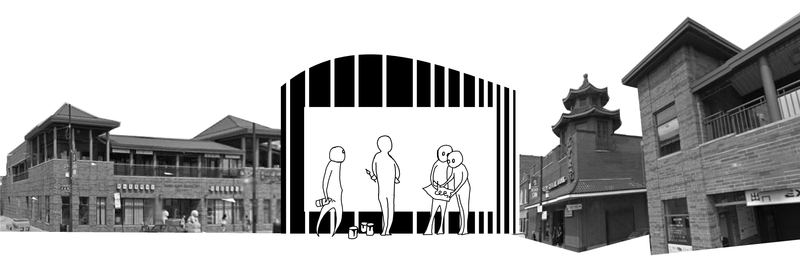Early on weekday mornings, immigrants recently arrived from mainland China can be seen gathering by the Chinatown Gate on Wentworth Avenue, chatting in Mandarin over hot tea and buns before dispersing across the city to their day jobs as drivers and restaurant workers.
Several blocks north of the gate, near Tony Hu’s ever-expanding restaurant empire and the Chinatown Square outdoor mall, weekday mornings are quiet. Not until evenings and the weekend does the space come alive with visitors from surrounding neighborhoods and the suburbs, including many second-and third-generation Chinese-Americans, arriving for boba tea, haircuts, and hot pot. Many residents of Chicago’s largest Chinese community lament this growing divide between the southern and northern parts of the neighborhood, which have come to be known as “Old Chinatown” and “New Chinatown.”
A new $18 million Chinatown public library branch on the corner of Archer and Wentworth Avenues, set to open this summer, hopes to bridge these two Chinatowns. The site of the glassy two-story building was strategically chosen as a midway point between the centers of the new and old Chinatowns, increasing pedestrian traffic between the gap.
The current Chinatown public library branch is housed in the rented bottom floor of a drab two-story retail center on the southern edge of Old Chinatown. It’s one of the city’s busiest library branches with over 21,000 visitors each month, and for years residents have complained of overcrowding and outdated technology.
“They were in desperate need for a new space and a new facility. They were in a rented facility for years, which did not meet the needs of the patrons. This will offer the opportunity to provide twenty-first century library services in a twenty-first century building,” said the Public Building Commissions project coordinator Molly Sullivan.
Because of the new library’s location on the triangular block that bisects the new and old Chinatowns, the design does not follow the typical cookie-cutter prototype used by most Chicago public libraries. It is being custom-designed and built by Brian Lee of Skidmore, Owings, & Merrill LLP. The rounded shape of the building was chosen in anticipation of the realignment of Wentworth Avenue, another aspect of recent civic efforts to connect New and Old Chinatowns.
The shape, orientation, and design of the sleek, 16,000 square foot structure adheres to the principles of feng shui, drawing inspiration from Chinese culture and uniting the architectural modernism of New Chinatown with the traditional architecture of Old Chinatown. According to the Public Building Commission, the library’s open central atrium design emulates the use of lighting and space in a traditional Chinese temple, and follows principles of feng shui by “having openness and a sense of connection to the second level.”
Permeable wooden fins attached to the building’s glass exterior will resemble a traditional Chinese screen, and vertical beams in the library’s garden will resemble bamboo stalks. Local artist CJ Hungerman will decorate the building with psychedelic art inspired by Chinese mythology.
Up until recent developments such as the new library branch and the realignment of Wentworth Avenue, New Chinatown has been the principal site of commercial and civic developments in the neighborhood. In the past decade, it has seen the major expansion of Ping Tom Memorial Park and Mayor Emanuel’s $62 million Wells-Wentworth Connector project, which will create a new road between Chinatown and the Loop.
The divide between Chicago’s two Chinatowns may, unexpectedly, point to a reason for pride among Chicago’s Chinese community. While Chinatowns across the nation—including lower Manhattan’s and San Francisco’s large Chinese communities—have been steadily shrinking in recent decades, Chicago’s Chinatown has increased by over twenty-five percent since 2000, and Chicago’s Chinese population is the third-largest ethnic group in the city. Newcomers are largely young, and of many different religious and geographic origins.
Perhaps the influx of a diverse community to Chinatown points to the fact that the neighborhood is thriving now more than ever. At the very least, the city’s investment in a new state-of-the-art library and other developments intended to connect the new and old Chinatowns suggests the entire neighborhood will continue to expand as a site of Chinese commercial and cultural activity in the coming years.
“This used to be an ugly parking lot,” said Sullivan of the future library site. “Now they’re building this beautiful, modern, state-of-the-art building, with views north to Chinatown Square and south to the Chinatown Gates, which has that big beautiful terra cotta arch. It’s being considered a new neighborhood hub.”


I think other Chicago residents of Chinese origin will likely agree with me that this cultural community is grateful to the city and its entire population for allowing us the commerce and resources to be who we are.